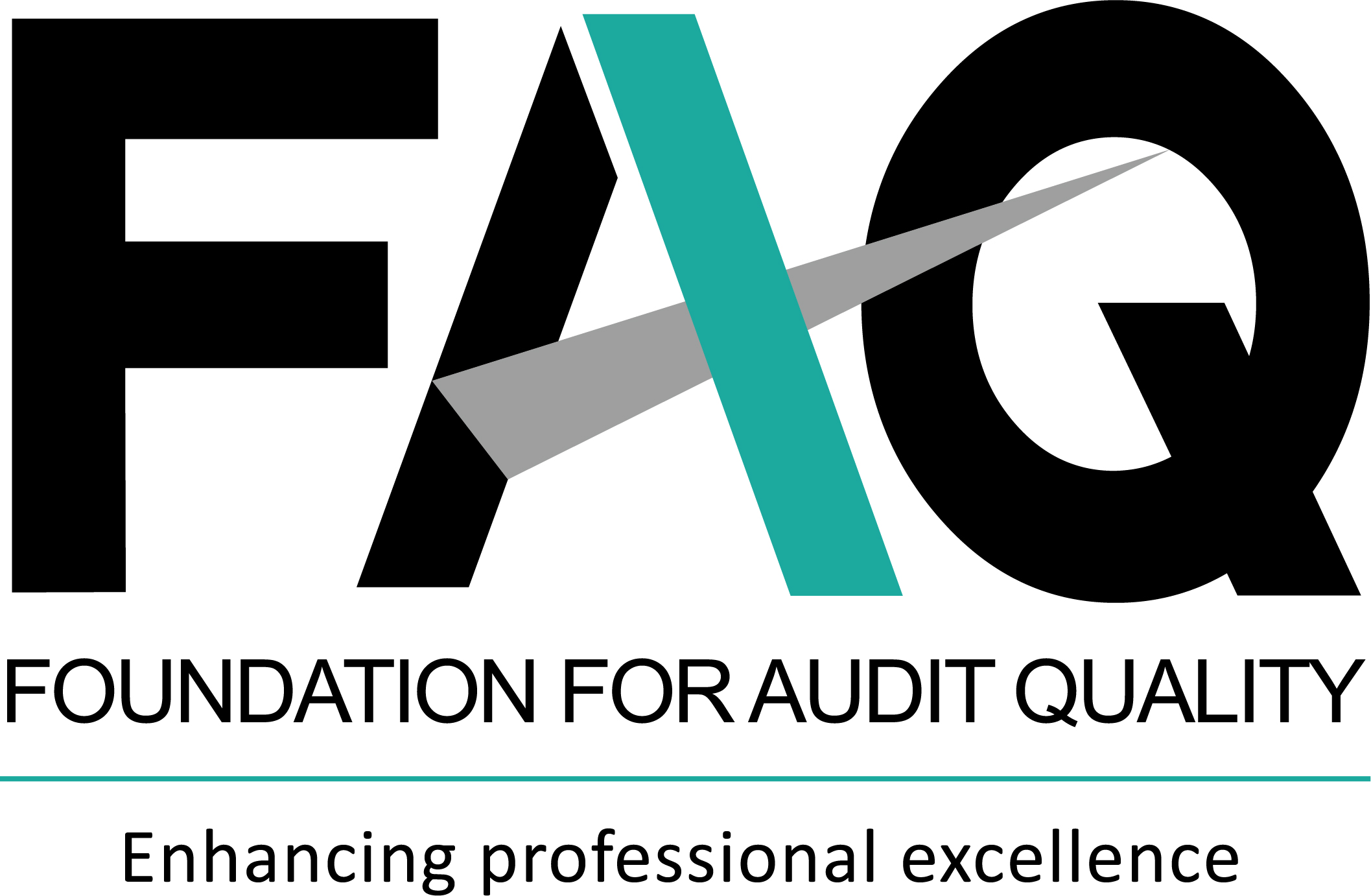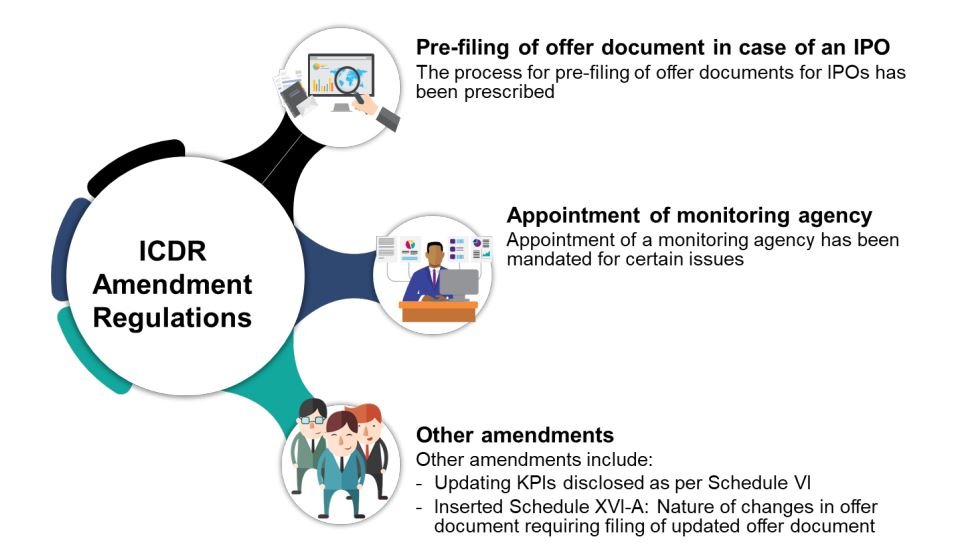Recently, SEBI, vide a notification dated 21 November 2022 issued amendments to the SEBI (Issue of Capital and Disclosure
Requirements) Regulations, 2018 (ICDR Regulations)26. Some of the key amendments issued include:
(Source: Foundation for Audit Quality’s analysis, 2022 read with ICDR Amendment Regulations)
Pre-filing of draft offer document
In May 2022, SEBI had issued a consultation paper27 proposing that issuers of securities be permitted to pre-file offer documents when
contemplating an Initial Public Offer (IPO).
The ICDR Amendment Regulations have incorporated the proposals by inserting a new chapter, ‘Chapter IIA, Initial Public Offer on Main
Board through pre-filing of draft offer document’ in the ICDR Regulations. Chapter IIA gives details of the steps to be followed while prefiling an offer document. The key guidelines prescribed by the ICDR Amendment Regulations are given below:
Step 1: Pre-filing of draft offer document with SEBI and the stock exchanges
Prior to an IPO, following documents will be filed with SEBI and the stock exchanges:
|
The Lead Manager (LM) associated with an issue will file the following documents with
SEBI:
-
Three copies of Draft Offer Document (DOD) in accordance with Schedule IV
along with fees in Schedule III
- A certificate confirming an agreement between the issuer and the LM
- A due diligence certificate issued by the LM in a prescribed form
-
In case of an issue of convertible debt instruments, a due diligence certificate
from the debenture trustee in a prescribed form
-
An undertaking, in a prescribed format, from the issuer and LM that they will not
advertise or market the issue
|
The issuer will file the following
documents with the stock
exchange where the securities are
proposed to be listed (stock
exchange):
- Pre-filed DOD
- Prescribed details of the promoter
|
Public notice
Within two days of pre-filing the DOD with SEBI, the issuer will make a public announcement* regarding the fact that the DOD has
been pre-filed (no other detail will be provided in the public announcement).
Issuer should also clarify that pre-filing of DOD does not necessarily mean that an IPO will be undertaken.
* All public announcements will be undertaken in one English newspaper, one Hindi newspaper and one regional language newspaper at the place
where the registered office of the issuer is situated. All three newspapers should have a wide circulation.
It is to be noted that pre-filed DOD will not be made available to the public.
Step 2: Changes and observations by SEBI
SEBI will recommend changes or issue observations on the pre-filed DOD within a prescribed time period.
Step 3: Updated Draft Red Herring Prospectus I (UDRHP I)
A. Submission of UDRHP I to SEBI
Changes suggested by SEBI will be processed by the issuer and LM on the pre-filed DOD, and a UDRHP I will be submitted to
SEBI28 along with:
-
a statement certifying that all changes, suggestions and observations made by SEBI have been incorporated in the offer
document
- a due diligence certificate issued by the LM in a prescribed format at the time of filing of the offer document.
B. Making UDRHP I public
The UDRHP I will be made public for comments for a period of at least 21 days from the date of filing. It will be hosted on the
websites of SEBI, the stock exchange(s) and of the LM.
Public notice
Within two days of filing the UDRHP I, with SEBI, an issuer will make a public announcement regarding the fact that UDRHP I has
been filed, and inviting the public to provide their comments to SEBI, the issuer and to the LM in respect of the disclosures provided
in the UDRHP I.
Step 4: UDRHP II
After expiry of the public comment period, the issuer and the LM will submit the following documents to SEBI:
- Comments received by them from the public on the UDRHP I and consequential changes required to be processed to the same
- UDRHP-II – (i.e., document issued after changes have been processed upon UDRHP I).
Step 5: Filing offer document
A. Before filing offer document
Before filing the offer document with the Registrar of
Companies (ROC), the LM will submit the following
documents to SEBI:
-
a statement certifying that all changes, suggestions
and observations made by SEBI have been
incorporated in the offer document;
-
a due diligence certificate issued by the LM, in
prescribed format, at the time of filing of the offer
document;
-
a copy of the resolution passed by the Board of
Directors of the issuer for allotting specified securities
to promoter(s) towards amount received against
promoters’ contribution, before opening of the issue;
-
a certificate from a statutory auditor, before opening of
the issue, certifying that promoters’ contribution has
been received in accordance with the ICDR
Regulations, along with stipulated details of the
promoters and amounts received from them;
-
a due diligence certificate issued by the LM, in a
prescribed format, in the event the issuer has made a
disclosure of any material development by issuing a
public notice pursuant to para 4 of Schedule IX of the
ICDR Regulations29.
B. Filing offer document
The offer document will be filed with ROC, and post that
with SEBI and the stock exchanges. It will also be hosted
on the websites.
The subsequent procedures with respect to price band
advertisement/issue opening would remain same as prescribed
in Chapter II.
Interaction with the Qualified Institutional Buyers (QIBs): The ICDR Amendment Regulations specify that the interaction
with QIBs would be permitted, provided such interaction is only
limited to the extent of the information contained in the pre-filed
draft offer document. Further, it has been provided that the issuer
must prepare a list of the QIBs who have participated in such
interaction and obtain a confirmation of interaction from the QIBs,
to be submitted to SEBI.
Appointment of monitoring agency
Requirement of monitoring agency:
Chapters V and VI of the
ICDR Regulations lay down the principles governing preferential
issue and Qualified Institutions Placement (QIP) respectively.
The ICDR Amendment Regulations have introduced the
requirement to have the use of the proceeds of the preferential
issues and QIPs monitored by a credit rating agency registered
with SEBI (acting as a monitoring agency) in certain cases.
Following principles have been specified in this regard:
-
Applicability: Where the issue size of the preferential issue
or QIP exceeds INR100 crore30, the issuer must appoint a
monitoring agency to monitor the use of proceeds of the
issue. However, this requirement would not apply to an
issue of specified securities made by a bank or public
financial institution or an insurance company.
-
Submission of report by the monitoring agency: The
monitoring agency would submit its report to the issuer in
the specified format, on a quarterly basis, till 100 per cent
of the proceeds of the issue have been utilised. Post this,
the Board of Directors and management of the issuer must
provide their comments on the findings of the monitoring
agency.
-
Submission of report to the stock exchange(s) and
upload on website:
The issuer should, within 45 days
from the end of each quarter, upload the report of the
monitoring agency on its website and also submit it to the
stock exchange(s) on which its equity shares are listed.
-
Preferential issue of shares of companies having
stressed assets:
The ICDR Amendment Regulations have
specified that in case of preferential issue of shares of
companies having stressed assets, the issuer should make
arrangements for monitoring the use of proceeds of the
issue by a credit rating agency registered with SEBI
(earlier
public financial institution or by a scheduled commercial
bank, which is not a related party to the issuer)
. Also, the
monitoring agency should submit its report to the issuer on
a quarterly basis till 100 per cent
(earlier until at least 95
per cent)
of the proceeds of the issue have been utilised.
Other amendments
Other amendments introduced by the ICDR Regulations include:
-
Amendments to Schedule VI of the ICDR Regulations:
Part A of Schedule VI of the ICDR Regulations (Schedule
VI-A) deals with disclosures required in the offer document/letter
of offer. The ICDR Amendment Regulations have
introduced certain additional requirements in Schedule VI-A
of the ICDR Regulations, with regard to the Key
Performance Indicators (KPIs) disclosed by the issuer in the
offer document. These include:
-
Approval by an audit committee: KPIs disclosed in the
offer document must be approved by the audit
committee of the issuer company
-
Certification: KPIs disclosed in the offer document
should be certified by the statutory auditor(s), Chartered
Accountants, or firm of Chartered Accountants, holding a
valid certificate issued by the Peer Review Board of the
ICAI or by Cost Accountants, holding a valid certificate
issued by the Peer Review Board of the Institute of Cost
Accountants of India. The certificate issued in this regard
must be included in the list of material documents for
inspection.
-
Explanation of KPIs: KPIs disclosed in the offer
document should be comprehensive along with an
explanation stating how they have been used by the
management historically to analyse, track or monitor the
operational and/or financial performance of the issuer
company. Further, the issuer company should also
explain the comparison of KPIs over time, based on
additions or dispositions to the business, if any.
-
Disclosures under ‘Basis for Issue Price’ section:
The issuer company is required to make certain
disclosures under ‘Basis for Issue Price’ section. Some
of the key disclosures required to be made are as
follows:
-
Disclosure of all the KPIs that have been disclosed
by the issuer to its investors at any point of time
during the three years preceding the date of filing of
the DRHP or Red Herring Prospectus (RHP),
-
Confirmation by the audit committee stating that the
verified and audited details for all the KPIs that have
been disclosed to the earlier investors at any point of
time during the three years, prior to the date of filing
of the DRHP/RHP are disclosed under ‘Basis for
Issue Price’ section of the offer document,
-
Comparison of the KPIs disclosed with Indian listed
peer companies and/or global listed peer companies,
as the case may be.
Effective date31: The amendments are effective from the date
of publication in the Official Gazette, i.e., 21 November 2022.
To access the text of the ICDR Amendment Regulations, please click here
-
The amendments have been issued by the SEBI (Issue of Capital and
Disclosure Requirements) (Fourth Amendment) Regulations, 2022 (ICDR
Amendment Regulations).
- https://www.sebi.gov.in/reports-and-statistics/reports/may-2022/consultation-paper-on-pre-filing-of-offer-document-in-case-of-initial-public-offerings_58875.html
-
There has to be a minimum prescribed time gap between the date of
intimation to SEBI about the completion of interaction with the qualified
institutional buyers and the date of filing the UDRHP I.
-
Schedule IX of the ICDR Regulations deals with public communications and
publicity materials.
-
In case of a QIP issue, the threshold of INR100 crore would exclude the size of
offer for sale by selling shareholders.
-
The amendments to Schedule VI of the ICDR Regulations would be
applicable for all issues where RHP is filed with the Registrars of
Companies on or after the date of publication of these amendments in the
Official Gazette i.e., 21 November 2022.
Action Points for Auditors
As per the ICDR Amendment Regulations, the lead
manager(s) is required to submit various documents to
SEBI before filing the offer document with the Registrar of
Companies. One such document that needs to be submitted
is the certificate from the statutory auditor(s), certifying that
the promoters’ contribution has been received in
accordance with the ICDR Regulations. It should be
accompanied therewith the names and addresses of the
promoters who have contributed to the promoters‘
contribution and the amount paid and credited to the
issuer‘s bank account by each of them towards such
contribution.
Further, it has been mentioned that the KPIs disclosed in
the offer document must be approved by the Audit
Committee of the issuer company and duly certified by the
statutory auditor(s) or Chartered Accountants or firm of
Chartered Accountants, holding a valid certificate issued by
the Peer Review Board of the ICAI or by Cost Accountants,
holding a valid certificate issued by the Peer Review Board
of the Institute of Cost Accountants of India. Thus, auditors
should engage with the companies intending to go for an
IPO and take note of the amendments introduced by the
ICDR Amendment Regulations.


